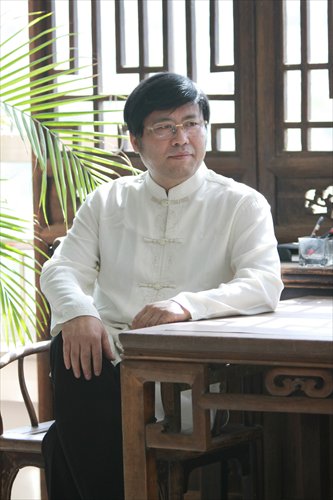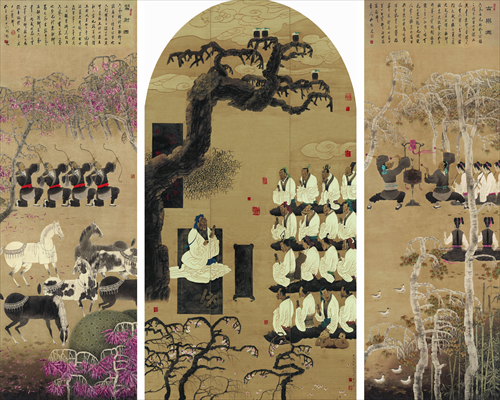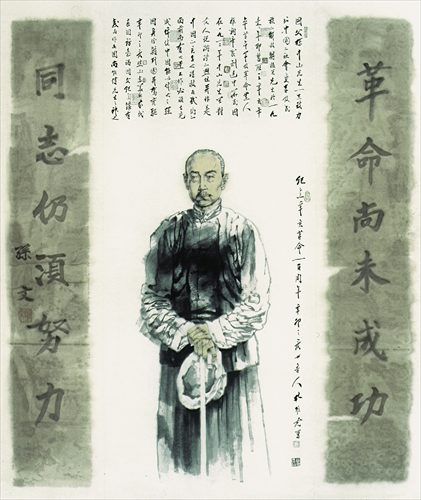Kong Weike: paying tribute to life through art
A famed painter, and 78th-generation descendant of Confucius, looks back on six decades of work
Editor's Note:
One of China's most influential modern artists, Kong Weike specializes in ink paintings that often feature themes related to Confucius and Confucianism. He also paints scenes of rural life using techniques drawn from classical Chinese art. These works not only demonstrate Kong's affection for his rural upbringing, but his deep understanding of art and profound ability to integrate modern artistic concepts with traditional techniques. Also inherent in his work is the idea of expressing truth and morality through art.
As a result, Kong's works are an excellent representation of Chinese traditional culture and modern charms, as well as a record of the country's history and present.

The famous Chinese artist Kong Weike in his studio Photo: Courtesy of Kong Weike
In 1956, the Year of the Monkey, Kong Weike, a traditional Chinese ink painting artist, was born in Shandong Province. This year, 2016, which is also the Year of the Monkey, Kong will mark his 60th birthday on June 12, in honor of which he will hold an exhibition of his works in his hometown.
Kong started drawing when he was only 3 years old. As a teenager, he began making money off his drawings. Practice was the key to his early understanding of art.
Most children like to draw, but their interest often ends up shifting to other things. But Kong's interest never wavered; from the time he first picked up a crayon in kindergarten, his life's path was chosen. Though his tools changed from crayon to water color brush, oil painting brush, carbon pen and ink brush, his obsession with art has always remained.
Kong started out painting posters for movie theaters, stage sets for traditional operas and outdoor advertisement posters, experiences that created a solid foundation for his painting skills. Once he found his favorite painting form, traditional Chinese ink painting, he dug in, spending the next few decades focusing on the medium of rice paper.
Although famous for his traditional ink painting, he also enjoys doing pencil sketches. Over the past nearly five decades, he has made hundreds of sketches that capture the charm of life and nature.
At first, his drawings were just a personal affair that he placed in his own home. Later, friends and neighbors began appreciating his work, and soon art schools and universities asked for his drawings. Today, they appear in exhibitions across the country, and have become part of the collections of the National Museum and the National Art Museum of China.
"I did go through a lot of pain as well as joy and sweat during those years, but now that I look back, the memories of those hardships have faded and the only clear thing that remains is the works," he said. "They are a record of my emotions, of my creative development and also of different points in my life. As a result, I wanted to hold an exhibition of these works, so that people, especially those in my hometown, can understand me better and my thoughts on art."
Kong believes that art serves as a powerful cultural and historical record, and that works from the past serve as a means of connecting with bygone dynasties and eras.
"We cannot see for ourselves what the Qin Dynasty (221BC-206BC) was like, but they left us with a system of universal currency and household registration. Likewise, we can never meet the poets living during the Tang Dynasty (618-907) and the Song Dynasty (960-1279), but we can read the poems they wrote. Many dynasties are not known to most modern people, but we have the historical records left by the people of those dynasties, and these are all culture." He said that art is an important part of culture, and what he has done with his life is just a single branch of art. But he thinks his works can reflect the world, and help him better understand life.

Xi She Tu 220×91cm, Xing Tan Jiang Xue 220×143cm, Gu Yue Tu 220×91cm
Kong's best friends over the years have been his ink brushes. On his desk are a pair of paperweights on which he has engraved a couplet describing his creative life: "A small painting desk holds the sky and the earth, and a single ink brush draws all things from past to future." As a descendant of Confucius, Kong is very conscious of his responsibility to promote ethics and convey truth through his art. A disciplined artist, he also knows how important it is to work every day to continue improving his skills. About 15 years ago, he established a gallery in Qingdao, Shandong Province, and at the gate he posted an engraving of a couplet that he wrote himself: "Self-cultivation, high moral standards and talent are the basis of self-discipline. Hard work, contentment and humility bring happiness."
According to Kong, every career requires lifelong dedication and training. He believes that artists like himself can spend day after day studying their discipline until their skills reach their peak. Over more than 50 years of dedication to his own art, and through the richness of his life experiences, his understanding of art has gradually improved.
As this exhibition covers 60 years - a lifetime of development as a person and an artist - it has caused Kong to reflect on how his attitudes have changed throughout the years. He describes those changes below, decade by decade:
"Ages 10 to 20: Drawing is good for me because it makes me feel free. There's no discrimination in drawing, and people appreciate me. The amount of time and energy invested yields an equal return.
"Twenty to 30: I have thought about many ways of making a living, but if it doesn't include drawing, I will be totally at a loss.
"Thirty to 40: People's lives, especially that of an artist, should have their own features and characteristics. The earlier I find them, the better.
"Forty to 50: Politics are the seat of power, but they are too cruel. The economy is the basis of living, but it is too realistic. Science is the path to progress, but it is too serious. Only art can bring people romance and happiness, making them relax in real life.
"Fifty to 60: The history of drawing is a history of aesthetic improvement. As a result, if a painter wants to be remembered by the world, he must think independently and leave his descendants new things.
"At 60: What is art? I do not think there is a standard answer to this question. Before, I thought art was a song of praise for life. Later, I thought art was the crying of one's own heart. Now I think art is the reflection of an era's spirit. So an artist's influence depends on whether he can understand the historical period he is in and reflect on it with his works."
Kong is excited to be holding this exhibition, and hopes it will be a great success. "When I was 3, I happened to see my teacher drawing and I started to imitate her. Who would have thought then that drawing would become my life's greatest pursuit?" he said. "I picked up the drawing pen and left my hometown when I was young, and now at 60 I have returned with a lifetime of works. It goes back to the starting point, like falling leaves settling on their roots."

Portrait of Sun Yat-sen

Gong Che Shang Shu 308cm×600cm 2009

Introduction to the artist
Kong Weike is a famous Chinese artist who specializes in traditional ink painting and has been recognized as one of the country's most important painters. He is a 78th-generation descendant of Confucius.
Kong's works have profound philosophical meanings related to life and art. Many have been displayed at the National Fine Arts Exhibition.
Celebrated Chinese artist Kong Weike, who specializes in traditional ink painting, was born in Wenshang county, Shandong Province in 1956.
Known as one of the most important painters of his generation, Kong is also a descendant of the philosopher Confucius.
Kong is a member of the National Committee of the Chinese People's Political Consultative Conference (CPPCC), a member of the China Council for the Promotion of Peaceful National Reunification, deputy chairman of the Shandong branch of the Revolutionary Committee of the Chinese Kuomintang (RCCK), deputy chairman of the World Federation of Confucius Descendants, a member of the China Artists' Association, the honorary director of the cultural and arts research center at Peking University's School of Arts, a specially appointed researcher at the Chinese National Academy of Arts, deputy director of RCCK Gallery, deputy chairman of the Literary Federation of Shandong Province, director of the Shandong Chinese Painting Institute and director of the Shandong Painting Academy.
Kong's works mainly focus on Confucius and Confucianism, and attempt to inject truth and ethics into art.
His most famous works include Confucius Zhou You Lie Guo Tu, Gong Che Shang Shu, Mu, Xing Tan Jiang Xue, Gao Shi Tu and Bai Ying Dian Quan.
His works have won multiple honors in both national art exhibitions and international competitions over the years.
Many of Kong's paintings also feature important Chinese political figures, including Kong Fansen, an honest and upright communist; Wang Jinmei and Deng Enming, founding members of the Communist Party; and Sun Yat-sen.
A number of these paintings are included in textbooks, art books and even dictionaries.
Kong has published more than 50 books of his works, including collections of sketches, paintings, poetry and calligraphy.